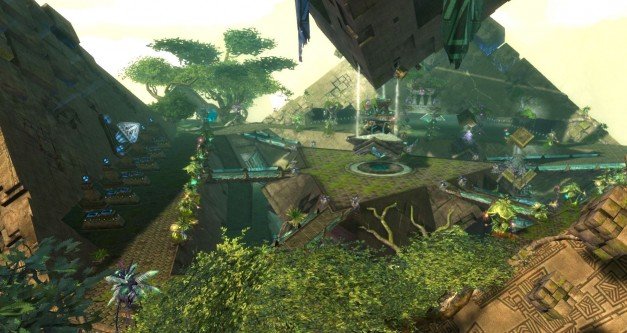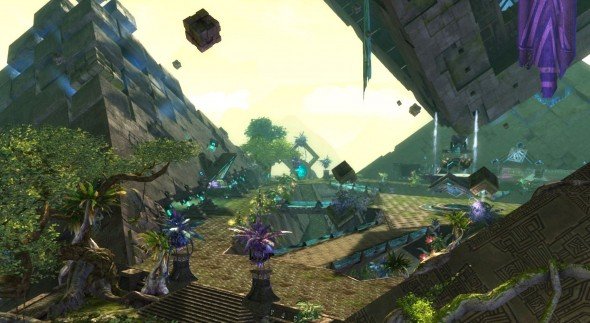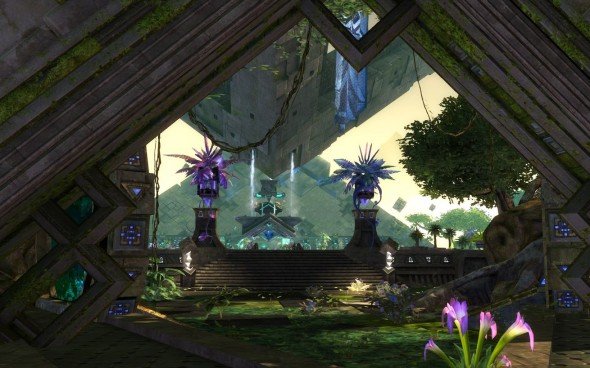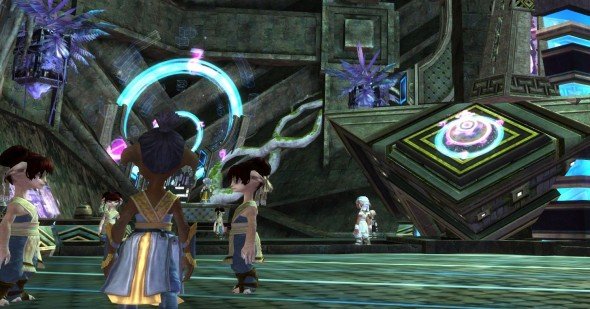Guild Wars 2 Asura interview part one: Rata Sum, the floating city

Yesterday, NCsoft and ArenaNet released a metric ton of info on the egotistical race of mini-geniuses known as the Asura, one of the many playable races in Guild Wars 2. Earlier this week, we sat down with Game and Content Designers Jeff Grubb and Ree Soesbee to talk about the smallest sentient beings of Tyria. In part one of this two-part post, we gleam insight on the Asura capital city, Rata Sum, and the golems that act as the brawn to the Asuras' brains.
PCG: What led to the decision to make Rata Sum a levitating city, rather than returning them to their roots underground?
Jeff Grubb: Well, one is a superiority thing. They're above it, they're basically showing off. But another reason is that Tyria is a very plastic landscape. The type of thing where land either sank beneath the waves, or rose up between the waves. Primordus, the one who drove them from their underground lairs, is still underground, they're still dealing with that. The idea of the most defensible position is off the ground. And with that comes an implied portability. It's not just Rata Sum—you go out into the Metrica province, which is right outside, and you'll find floating buildings out there. You'll find a lot of their structures have power stones under them to levitate so that, if need be, they can move them somewhere else. Could Rata Sum move? It would have to be a really big threat. It would have to be like a dragon champion taking up residence right on top of them. But the idea of, it's a much more defendable position than on the ground.
PCG: Are we going to see a lot of the subterranean roots of Rata Sum? Like underground elements specifically.
Ree Soesbee: There's an underground area of Rata Sum—Rata Sum has some deep clefts that you can stand at the top of and look down on and see golems and Asura working to clear the mines.
JG: Asura are a spectrum, so there are Asura who feel that, when they were driven to the surface, they lost knowledge, and so there is stuff to be found down below. The old labs, the old cities, and some of our story gives an insight into that recovery of lost knowledge. This is one of the problems for the Asura: they're a race of mad wizards who are all individualists, who are all going off and making individual discoveries, and then stuff gets lost. And some of Asura feel, we should be moving back in. We should be moving down below—if we can take care of the elder dragons. Once that's taken care of, that's one more area we can expand into. But we've lost stuff when we had to book it out of there.

PCG: Will players get to experience the recovery of some of this lost knowledge?
Keep up to date with the most important stories and the best deals, as picked by the PC Gamer team.
JG: Yeah.
RS: We have dynamic events and so forth that will take you into the underground, but we're not actually taking back the old Asura cities right now. They're just far too dangerous.
JG: It's more likely to be something similar to Oola's old labs.
RS: Old labs and so forth. Individuals who have found things under there and are doing stuff with it that you have to investigate.
PCG: Since Asura always want to be the best and brightest individuals, is this going to be reflected in the size of the city? Are we going to see a massive thing here, kind of a “we can build the biggest city” attitude?
RS: I don't know that it should be in any way correlated with the Asura that "bigger is better." I just don't think that's the case.
JG: We are short, you're freakishly tall.
RS: In their opinion, they have the best city of course. It has the most magic, it has floating things, it has brilliant lights, it has magnificent architecture, it has wonderful gardening, the works. The area around it is lovely—it has views, and it has exceptional laboratories, and I can say with 100 percent certainty that the Rata Sum laboratories are second to none in the world, and that's the most important thing to them.
JG: It's also close to mass transit and schools.

PCG: Well, speaking of mass transit, let's talk about Asura Gates—are they going to be a method for traveling around the world, of getting from place to place?
JG: Yes. In Eye of the North, they had of course built their central transit hub right over a strong source of arcane energy, which, by the way, turned out to be an elder dragon. And when the Great Destroyer arrived, they used that hub to spread through the underground and bring about the devastation. Now, the Asura has fixed that hub, but they are still using Asura Gates to transfer across the world. So there's an Asura Gate in Divinity's Reach, there's an Asura Gate in Hoelbrak. So the end result of this means that, if you're playing a Norn, and you want to play with your friend who's an Asura, you can get to Rata Sum without too much problem. From a social aspect, it means that the Asura are infiltrating and investing much more in the other races. So there'll be an Asura Gate in the Black Citadel. They have it away from everything else, they keep an eye on it, they're very suspect of the whole idea that here's one more gate into our city, but there is an Asura Gate in the Black Citadel.
PCG: How about these colleges that you mentioned? What's their significance for Asura players?
JG: If you're playing a Charr, you choose a legion in your initial story. If you're playing a Human, you choose a social class. If you're an Asura, you choose your initial college. Each of the colleges has a different outlook on the universe, how they're going to solve everything. The Asura believe in the eternal alchemy: that everything is a big machine, a big equation that can be solved, a big machine where everything interacts with everything else. How they approach it depends on their college.

The College of Statics is more traditional, more conservative; those Asura who want to go in and find old knowledge that is lost tend to be of this college. This is where you're going to find people who are looking for the ancient artifacts, etc. They tend to be more stable, they're more structural—the floating castles and labs are a good example of their type of thinking. They're still using magic inherently—that's part and parcel of being an Asura—but they're using it in a very stable fashion.
The College of Dynamics is much more active. Much more energetic, much more explosive. They are experimenters. Their belief is to move everything forward. They are the ones who are building new creations. They are the ones who are coming up with radical new plans and if it does not necessarily work, the important thing is to what we learn from what we've done to move forward. An experiment where you learn is a good experiment even if it isn't what you intended to learn. They are much more into energies, and devices.
The College of Synergetics is much more theoretical. They're a little more mystic. They're dealing with primal building blocks. They're saying, “What is magic? How far can you divide magic before it stops being magic? How does everything interact with everything else?” They're very much about the spaces between the cogs. They're about how different systems interact, they're the ones who were looking at larger ecosystems, or interactive personal systems, or how the planets spin around the sun. An example I've been using has been, think of it as three branches of engineering: the school of statics is civil engineers, those of dynamics are chemical engineers, and those of synergetics are nuclear engineers, because they're working with forces they cannot necessarily examine firsthand.

PCG: Tell us more about golems. Are they still a major part of the Asura and Rata Sum?
JG: Very much so, and there's a wide variety of golems. The most traditional golem you see will be the big radio-type golem that you see in the demos right now. It looks like an old RKO radio, that's what it reminds me of. But there are other types of golem forces they use as well.
RS: And one thing that can be pointed out is that the Asura are very efficient in the use of golems. Where the Humans have the Seraph to protect Divinity's Reach, and that'll be a team of five or six guys going about and handling trouble, the Asura have one Asura who does the same job—but he has multiple golems who assist him in keeping down trouble and in handling problems in the city. And the peacemakers, who're the city guards for the Asura, are really very efficient in their use of those golems, and how they bring that technology to bear for the benefit of the city.
Want the rest of the interview? Check back Monday for more goodness when we detail the culture, conflict and softer side of the Asura.

